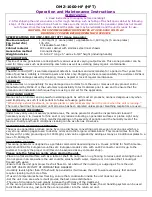
YORK
5587001-YSG-A-520 | Start-Up & Operation Guide
42
To change the setpoint via BAS, set the DAT-SP-
config to fixed (
Details
>
Clg
>
Setup
), and write the
setpoint directly to the ClgDATLo-Sp BAS setpoint.
Changes in the external control signal result in a
reset of the active DAT setpoint based on two other
setpoints.
•
DAT Low Setpoint:
This is the minimum val-
ue the user wants for the DAT
•
DAT High Setpoint:
This is the maximum
value the user wants for the DAT
When the external control signal is 10 VDC, the ac-
tive DAT setpoint is the DAT low setpoint.
When the external control signal is 0 VDC, the ac-
tive DAT setpoint is the DAT high setpoint.
When the external control signal is between 0–10
VDC, the active DAT setpoint is somewhere be-
tween the DAT low and DAT high setpoint.
For cooling and heating operations, the DAT varies
from the DAT high setpoint to the DAT low setpoint
as the input varies from input range low to input
range high.
SZVAV Cooling Operation
On a rooftop unit configured for SZVAV operation,
the cooling sequence differs from units configured for
MZVAV operation. On a SZVAV unit, cooling demand
comes from one of two sources:
• A ZT sensor can either be hard wired or communi-
cated from a BAS
• A standard two-stage cooling/heating thermostat
Zone Temperature Sensor
The ZT sensor relies on which of the following sensors
are connected and reliable. When more than one is con-
nected and reliable, they are used in order of priority.
• BAS input (times out after 15 minutes when the
value is not updated)
• NetSensor
• Zone temperature sensor
• Return air temperature
When the operational zone temperature is greater than
the zone cooling setpoint, the unit enters an active cool-
ing mode. The unit controller regulates the DAT setpoint
based on the ZT demand. The supply fan operates at
the SZVAV cooling minimum speed (user adjustable).
When the DAT setpoint reaches the cooling DAT lower
setpoint for 5 minutes, the unit controller holds the DAT
setpoint at the cooling DAT lower setpoint. At this time,
the supply fan speed starts to increase based on ZT de-
mand.
Thermostat Control
The rooftop unit can be controlled by a 2-stage cooling/
heating thermostat. The unit responds to cooling/heat-
ing demands based on 24 VAC inputs:
•
Y1:
Low cooling mode
•
Y2:
High cooling mode
The cooling demands to Y1 and Y2 require the building
system interface board.
On a demand for Y1, the supply fan controls to the SZ-
VAV cooling minimum speed, and the active DAT set-
point is the DAT cooling high setpoint.
On a demand for Y2, the supply fan operates at 100%
fan speed, and the active DAT setpoint is the DAT cool-
ing low setpoint.
Compressors and Refrigeration Circuits
The rooftop units use single speed scroll compressors
as standard factory installed components.
Variable speed drive compressors are a factory installed
option. Variable speed drive compressors are always in-
stalled on the first circuit only.
Compressor staging is completed utilizing a patented
algorithm.
Liquid line filter driers and moisture indicating sight
glasses are standard factory installed components. Re-
placeable core filter driers are an option.
Refer to
pressor layouts and
for correct numbering.
Condenser Fan 1A
Condenser Fan 2A
Condenser Fan 2B
Condenser Fan 1B
Left
Mid-Left
Mid-Right
Right
LD28039
NOTE:
On 25–30 ton units, only two condenser fans are installed.
When facing the compressor end, condenser fan 1A is on
the left and condenser fan 2A is on the right.
Figure 17: Condenser Fan/Compressor Locations
















































